|
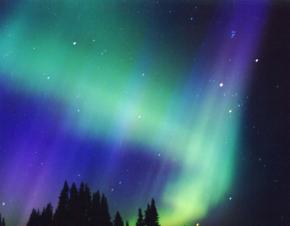 August 14, 2000 -- An interplanetary shock wave from the Sun struck Earth's magnetosphere just before the peak of the Perseid meteor shower on August 12, 2000, triggering a powerful geomagnetic storm. Stargazers across Canada and the United States were treated to the rare spectacle of a meteor shower seen against the backdrop of colorful Northern Lights. August 14, 2000 -- An interplanetary shock wave from the Sun struck Earth's magnetosphere just before the peak of the Perseid meteor shower on August 12, 2000, triggering a powerful geomagnetic storm. Stargazers across Canada and the United States were treated to the rare spectacle of a meteor shower seen against the backdrop of colorful Northern Lights.
Right: Daniel Hershman captured this dazzling picture on August 12, 2000, at Sunrise Point in Mt. Rainier National Park, WA. The three bright lights near the right side of the image are Jupiter, Saturn and the red star Aldebaran. [more pictures]
Plenty of astronomy enthusiasts were outdoors on Friday night and Saturday morning hoping to catch a glimpse of the annual Perseid meteor shower. Most years the Perseids are impressive all night long around the shower's peak on August 12th, but in 2000 the bright nearly-full Moon threatened to outshine all but the brightest meteors. Observers were pinning their hopes on a brief 90-minute window of dark skies between moonset and sunrise on Saturday morning.
Sky watchers will remember what actually happened for many years. The shock wave from a coronal mass ejection that left the Sun on Wednesday, Aug. 9th, hit Earth's magnetosphere Friday night. It triggered a brilliant sky show over Western Europe and North America that began much earlier and looked much different than the one meteor watchers expected.
James Westlake, a professor of astronomy at the Colorado Mountain College in Steamboat Springs, was camping with the CMC Sky Club on Friday night when the sky erupted in color.
"It was a surprise. Bright red, green and blue curtains and fountains of light seemed to pour out of the top of Hahn's Peak, an extinct volcano just north of Steamboat Springs," said Westlake. "The auroral display began around 9:45 p.m. MDT on Friday and continued into the dawn. It was by far the best I've seen from Colorado during this current solar cycle. And ... how incredible that it occurred during the peak of the Perseids!"
 Left: The mountain crest at the center of this photo is Colorado's Hahn's Peak illuminated by the nearly full Moon. Credit: James Westlake, August 12, 2000. Left: The mountain crest at the center of this photo is Colorado's Hahn's Peak illuminated by the nearly full Moon. Credit: James Westlake, August 12, 2000.
Northern Lights are usually confined to high latitudes (greater than 50 degrees), but these were spotted as far south as Los Angeles, CA (latitude 35 degrees). The auroras were so intense that they shined through the competing glow of Southern California's urban lights.
"I got up at 3 a.m. [Saturday morning] to watch for Perseids and counted 5 in a 15 minute period," wrote Science@NASA reader Alexandra Florimonte, who lives in a suburb north of Los Angeles. "After 15 minutes I went back to bed. My husband, however, came in a few minutes later claiming he'd seen auroral bands. I thought he was joking, but he wasn't!"
Further north, in Bishop, CA, pink pillars of light danced along the top of the White Mountain Range. Observers said they found it difficult to look away from the eye-catching aurora to watch for meteors streaking across the sky. Occasionally, a bright shooting star would race across the shimmering Northern Lights -- it was an unforgettable sight.
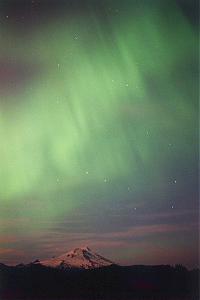 In dark-sky areas like Bishop, meteor watchers counted 50 to 105 shooting stars per hour after the Moon sank below the horizon at 3:30 a.m. on Saturday morning. Observers near brightly-lit urban centers recorded more modest numbers -- just 10 to 20 per hour. Many of the Perseids were bright and blue-colored with long-lasting trails. In dark-sky areas like Bishop, meteor watchers counted 50 to 105 shooting stars per hour after the Moon sank below the horizon at 3:30 a.m. on Saturday morning. Observers near brightly-lit urban centers recorded more modest numbers -- just 10 to 20 per hour. Many of the Perseids were bright and blue-colored with long-lasting trails.
Right: Wade Clark captured this image of the Big Dipper shining through green-colored auroral sheets in the skies above Skagit County, Washington State. The moonlit peak is Mt. Baker.
"At 4:02 a.m. EDT, a Perseid raced beneath Pegasus and blazed into a multicolored fireball of -8th magnitude," wrote Kim Youmans of the North American Meteor Society, who observed the shower from eastern Georgia (USA). "It left behind a 40 degree train that endured a whopping 28 seconds! ... I would see two more fireballs at -3rd magnitude before [my observing] session ended, and four other beauties that reached magnitude -4."
Several Science@NASA readers reported instances when meteors appeared to pass through the aurora borealis. In fact, meteors and auroras occur in different layers of our atmosphere. Perseid meteoroids burn up in the mesosphere, an atmospheric zone that extends from approximately 50 km to 90 km altitude. The lowest fringes of the aurora are at least 70 km high, and they can extend to nearly 1000 km above our planet (in the thermosphere).
For comparison, the space shuttle orbits near 300 km altitude. Only astronauts can fly through the aurora!
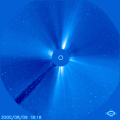 Left: The leading edge of this coronal mass ejection (CME), recorded on August 9th by the ESA/NASA Solar and Heliospheric Observatory, hit our planet's magnetosphere at 1930 UT on August 11th. The impact occurred just as the Earth was coincidentally entering the densest part of the debris stream from comet Swift-Tuttle -- the parent of the Perseid meteor shower. The timing of the G3-class
geomagnetic storm couldn't have been better for sky watching meteor enthusiasts. [see a 299 kb coronagraph animation of the CME] Left: The leading edge of this coronal mass ejection (CME), recorded on August 9th by the ESA/NASA Solar and Heliospheric Observatory, hit our planet's magnetosphere at 1930 UT on August 11th. The impact occurred just as the Earth was coincidentally entering the densest part of the debris stream from comet Swift-Tuttle -- the parent of the Perseid meteor shower. The timing of the G3-class
geomagnetic storm couldn't have been better for sky watching meteor enthusiasts. [see a 299 kb coronagraph animation of the CME]
If you missed this weekend's amazing sky show, don't worry. The Sun is near the peak of its 11-year activity cycle and experts say that high levels of geomagnetic activity could continue for another two years. Meanwhile, you can enjoy what others saw on August 12, 2000 by browsing the gallery of images below. All of the pictures were contributed by readers of Science@NASA and SpaceWeather.com.
SEND THIS STORY TO A FRIEND
Aurora Gallery -- Aug. 12, 2000
Unless otherwise stated, all images are copyrighted by the photographers.
| |
Photographer, Location |
Images |
Comments |
|
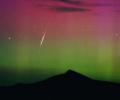
|
Jimmy Westlake, near Hahn's Peak, Colorado. |
#1, #2, #3, #4 |
The mountain peak at the center of this image is Hahn's Peak, an extinct volcano in Colorado, illuminated by the nearly full moon at 1 a.m. MDT on August 12, 2000. Images #2, #3 and #4 include meteors captured during the Perseid meteor shower. Photo details: 400 speed Kodak Max color print film, Nikon FE-2 camera, 50 mm lens at f1.8, 20 second tripod-mounted exposure. |
|

|
Debbie Kinloch, York, Ontario, Canada. |
#1, #2, #3, #4 |
Image #1 is south of the zenith, where a coronal aurora developed. Photo details: Nikon FE 28mm/f 3.5, Kodak 200 ASA film for 30 seconds. |
|

|
Daniel Carene, Lewiston, Michigan. |
#1, #2 |
The Pleiades, Jupiter and Saturn are visible in the first image. Photo details: Minolta X-570 camera, 50mm, lens, f-stop 1.7 , Kodak 800 film, 2-3 second exposures. |
|

|
Jeffrey Rodgers, Glacier Point, Yosemite National Park |
#1, #2 |
Photo details: Pentax K1000, Fuji 800 print film, 50mm lens at f/2, 15-30 sec. |
|
 |
Chris L. Grohusko, 32 miles NE of El Paso Texas in Hueco Tanks State Historical Park |
#1 |
This picture includes a Perseid meteor shooting through unusual red aurora over Texas. Photo details: The photographer used a 28mm lens on a Pentax K1000 tripod-mounted camera , f/2.8, Fuji Superia 800 Xtra Film. |
|

|
Daniel Hershman, Sunrise Point, Mt. Rainier National Park, Washington State |
#1 |
This photo was taken at 3 a.m. PDT on Aug. 12, 2000. The brighter stars just under the Pleiades are Saturn and Jupiter. Photo details: Kodak Max 800 film with a 28 mm lens on a Minolta XG-9 35mm camera. Exposure was 30 seconds at f 3.5. |
|

|
David Lee, Island View Beach, Victoria, BC, Canada |
#1, more |
This spectacular fish-eye view was captured at 3:45am PDT August 12 2000. Photo details: Nikon 90FX camera with 16mm/2.8 full-frame fisheye lens; Fuji Superia 200 film; 30 seconds exposure at f/2.8 |
|

|
Wade B Clark Jr, Skagit County, Washington State |
#1, #2, #3, #4, #5 |
The moonlit mountain in the first three photos (taken from Baker Lake in northwest Washington State) is Mt Baker. Photo #4 was captured from the photographer's front yard near Lyman, Washington. The Big Dipper is visible in photos #1-#3. |
|

|
Tom Warner,
Rapid City, SD |
#1,#2 |
Image #2 includes a bright Perseid meteor. Photo details: Nikon FM2 with Kodak 100vs slide film. Exposure was 2 minutes at f4 using a 28-200
lens. |
|
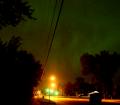 |
Pete, St. Paul, MN |
#1, #2, #3,
animation |
Image #1 shows green-colored aurora in the skies above St. Paul, MN, with city lights in the foreground. The first three photos are 8 second exposures with a Sony DSC-S70 digital camera. |
|
 |
Douglas Schmutz,
Hamblin Valley, Utah |
#1, #2, more |
Image #1 includes a faint Perseid meteor near the bottom-center. |
|

|
Joe Bauman, near Knolls, Utah. |
#1, more |
Photo details: Fujicolor 400 color film, Nikon camera, 28-mm lens, mounted on a star-tracking Celestron telescope, 3 minute exposure. |
|
 |
Michael Gordon, north of Marion, Ohio |
#1, #2, #3,
#4 |
Photo details: These images were recorded on Kodak Gold 100 film through a 50mm lens at F/1.8. |
|
 |
Brenda Culbertson, Mayetta, Kansas |
#1, #2 |
These photos of green, yellow and red aurora over Kansas were captured between 08:00 and 10:35 UT
on August 12, 2000. |
|
 |
Stan Richard, Saylorville Dam just north of Des Moines, IA |
#1, #2, #3,
#4, #5 |
Photo details: The photographer used a 28mm lens @f/3.5 and exposed for 30-45 secs on Kodak Royal Gold 400 print film. |
|
 |
Mike Lynch, Frankfort, KY |
#1, #2 |
Photo details: The photographer used 400 ASA Fuji film, 10-second exposures, a 28 mm Pentax
lens (image #1) and the same lens with a semi-fisheye adaptor (image #2). |
|
 |
Claudio Sfreddo, Lillooet, Canada (300 km North of Vancouver, BC) |
#1, #2 |
Photo details: The photographer used Fujicolor Superia 400 film with 4 to 30 second exposures at f/4. |
|
 |
Scott Wright, Ashtabula. OH |
#1, #2, #2 |
Photo details: The photographer used an "old" 1969 Nikon F camera with a 1.4 50mm lens. Exposure times were 1 to 3 minutes. |
Science@NASA readers describe what they saw
on August 12, 2000
- " We had almost decided it wasn't worth driving all the way to Yosemite just to have the moonlight wash out the Perseid meteors. My wife insisted that we go anyway because she missed the meteors last year, and I also realized I could take some pictures of Half Dome (by moonlight). We arrived at Glacier Point area around 2 a.m. and enjoyed the view while I took pictures. Finally, the Moon went down and we watched the meteors when I noticed it, that interesting light. I soon realized we were seeing an aurora for the first time! It didn't have bright colors, but there was a real intense area that grew taller, and beautiful "cutains" of light. I can't believe I saw the "Northern Lights" from this far South (California, USA)
and I'm sure glad I had my camera, tripod and cable release." -- Jeffrey Rodgers
- "The Northern Lights really kicked in as the Moon set," says Ralph Bacon, who watched the August 12th display from his home near Ashtabula, Ohio. "Great sheets of light rolled and pulsated from north to south, with streaks and whorls extending 105 degrees across the sky. I got my wife and son out of bed. Together we watched the heavens spellbound. [We saw] meteors at all points of the compass, and we counted a total of 85 Perseids [in less than 80 minutes]."
- "The exact time [I took the aurora photos] was unknown because I was out watching the meteor shower when the storm began. In my excitement -- it was my first aurora -- I didn't record a single thing. I just grabbed the camera and ran up a small hill in front of the house to photograph the Northern Lights. I ran out of film before it was over...." Mike Gordon, a first-time aurora photographer near Marion, Ohio.
- "We had a fantastic session of Perseid observations ... from Mathias, West Virginia, USA. After moonset, the Perseids and Aurora showed their full glory! The best hour was 7:45 to 8:45 UT when [we saw] 75 Perseids while curtains of auroral light danced in the northern sky! It was the best Perseid maximum I've seen since 1967 when I saw 103 Perseids an hour. Several fireballs were seen." North American Meteor Society member George Gliba.
- "I was fishing late last night and the Northern Lights could be seen for about 20 minutes.
Incredible! Shame we could not see the meteors." Peter Alexander in Taupo, New Zealand. Editor's Note: Perseid meteors were not visible far south of equator because the shower's radiant is near the North Star. However, "Northern Lights" (really "Southern Lights") were visible in New Zealand thanks to the active auroral oval around Earth's south pole.
- "It was the most amazing thing I have ever seen. I did not know that the aurora was so dynamic. Ever changing, pulsating, arcing and sweeping across the sky. I was mesmerized. I watched them from 10:30 pm August 11th to 5:30 am August 12th. I saw many shooting stars, as that was the initial reason for being up north that weekend. At one point, for about 2 hours I was directly underneath a pulsating cloud of aurora. It looked like a giant amoeba in the sky. I can only guess at the fear that a display of this magnitude had on ancient humans of the past." -- Daniel Carene, Lewiston, Michigan
- "After 2 days, I am still in total excitment and can't believe what I saw. We were driving north of Lillooet (300 km North of Vancouver, BC) to find a place away from the light pollution ... for the meteor shower ... But we [stopped] 40 km before our final destination to enjoy a show which seemed to come right out of a dream: curtains of light flashing, flickering, pulsating, arcs of light stretching all over our heads on a NW-SE line. The sky was dancing, and we were in total awe. No picture can reproduce the beauty of such a show. Just one month before my trip back to Switzerland, that was surely the best farewell gift Nature could ever give me. --Claudio Sfreddo
|
 Left: The mountain crest at the center of this photo is Colorado's Hahn's Peak illuminated by the nearly full Moon. Credit: James Westlake, August 12, 2000.
Left: The mountain crest at the center of this photo is Colorado's Hahn's Peak illuminated by the nearly full Moon. Credit: James Westlake, August 12, 2000. In dark-sky areas like Bishop, meteor watchers counted 50 to 105 shooting stars per hour after the Moon sank below the horizon at 3:30 a.m. on Saturday morning. Observers near brightly-lit urban centers recorded more modest numbers -- just 10 to 20 per hour. Many of the Perseids were bright and blue-colored with long-lasting trails.
In dark-sky areas like Bishop, meteor watchers counted 50 to 105 shooting stars per hour after the Moon sank below the horizon at 3:30 a.m. on Saturday morning. Observers near brightly-lit urban centers recorded more modest numbers -- just 10 to 20 per hour. Many of the Perseids were bright and blue-colored with long-lasting trails.